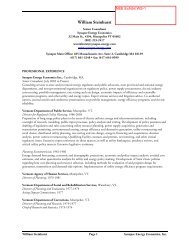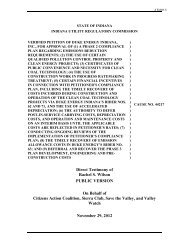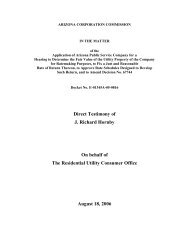Best Practices in Energy Efficiency Program Screening - Synapse ...
Best Practices in Energy Efficiency Program Screening - Synapse ...
Best Practices in Energy Efficiency Program Screening - Synapse ...
Create successful ePaper yourself
Turn your PDF publications into a flip-book with our unique Google optimized e-Paper software.
Recommendation<br />
<strong>Energy</strong> efficiency programs should not be screened at the measure level, because this is<br />
overly restrictive and ignores the important <strong>in</strong>teractions between measures, especially<br />
the fact that some measures that might not be cost-effective on their own but might<br />
nonetheless have important benefits <strong>in</strong> terms of encourag<strong>in</strong>g customers to participate <strong>in</strong><br />
programs or adopt other measures.<br />
As noted above, we recommend that energy efficiency programs be screened at the<br />
program level us<strong>in</strong>g the TRC test or the Societal Cost test, and that the entire portfolio of<br />
programs be screened us<strong>in</strong>g the PAC test. This allows regulators to balance the goal of<br />
achiev<strong>in</strong>g key public policy objectives (through the use of the TRC test or the Societal<br />
test), with the goal of ensur<strong>in</strong>g a net reduction <strong>in</strong> costs to customers (through the PAC<br />
test).<br />
When energy efficiency contractors screen efficiency measures <strong>in</strong> the field, the<br />
Participant Cost test should be used, to provide the customer with relevant <strong>in</strong>formation<br />
regard<strong>in</strong>g which measures to adopt. The TRC test should not be used for field screen<strong>in</strong>g<br />
energy efficiency measures.<br />
Illustrative Example<br />
Figure 5.3 presents cost-effectiveness at the program level, sector level, and portfolio<br />
level for our example New England utility. While each screen<strong>in</strong>g level <strong>in</strong>dicates that the<br />
energy efficiency activities are robustly cost-effective, the figure demonstrates that<br />
programs or sectors with lower cost-effectiveness can be absorbed by programs or<br />
sectors that are more cost-effective. For example, the low-<strong>in</strong>come sector has a benefitcost<br />
ratio of about 2.6, while the residential sector has a benefit-cost ratio of about 4.7,<br />
and the C&I sector has a benefit-cost ratio of about 3.5. On average, at the portfolio<br />
level of screen<strong>in</strong>g, the sectors produce a benefit-cost ratio of about 3.7.<br />
Figure 5.3. Cost-Effectiveness at Different Screen<strong>in</strong>g Levels<br />
Source: The 2012 energy efficiency plan for our example utility, with modified assumptions.<br />
<strong>Best</strong> <strong>Practices</strong> <strong>in</strong> <strong>Energy</strong> <strong>Efficiency</strong> <strong>Program</strong> Screen<strong>in</strong>g | www.nhpci.org | 57







